
The Solar-Terrestrial Centre of Excellence (STCE) is a collaborative network of the Belgian Institute for Space Aeronomy, the Royal Observatory of Belgium and the Royal Meteorological Institute of Belgium.
 |
Published by the STCE - this issue : 3 Oct 2013. The Solar-Terrestrial Centre of Excellence (STCE) is a collaborative network of the Belgian Institute for Space Aeronomy, the Royal Observatory of Belgium and the Royal Meteorological Institute of Belgium. |
| Archive of the newsletters | Subscribe to this newsletter by mail |
Once again, sunspot and related solar activity were very low last week. Nonetheless, the period featured two very nice eruptions during the evening hours of resp. 24 and 29 September. A movie of the events can be seen at http://www.youtube.com/watch?v=uf89aISuotk The images underneath show the eruptions as seen with the SDO/AIA 304 filter.

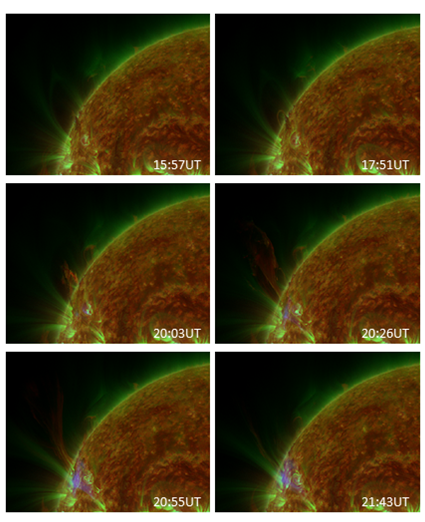
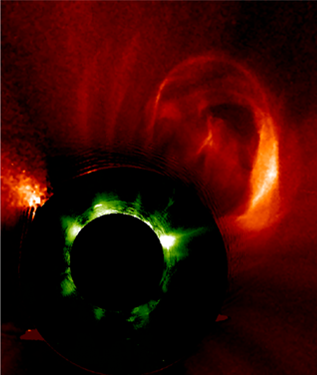
The source of the 29 September eruption was a long and solid filament in the northwestern solar quadrant. It had been transiting the solar disk since about 20 September, and gave the Sun a dark scar. Because of its length and solidness, space weather forecasters were expecting it to erupt.




Credit - Imagery for the images and movie were taken from SDO (http://sdo.gsfc.nasa.gov/data/), STEREO-B (http://stereo.gsfc.nasa.gov/), the GONG/H-alpha Network (http://halpha.nso.edu/), PROBA2 (http://proba2.oma.be/ssa ) and SOHO (http://sohowww.nascom.nasa.gov/ ).
From September 16 to 19, Leuven, Belgium was the scenery for an intensive training in solar-terrestrial physics. Around 40 participated, ranging from master students to PhD students and young post-doctoral researchers, taking the first steps in space research.
The eHEROES/CHARM school (http://wis.kuleuven.be/CHARM/events/school/SSTW2013/) focused on the theoretical approaches to space weather and its drivers, presented modern solar data analysis tools, and covered state-of-the-art solar and space science simulations. Participants learned about forecasting aspects and their quality control for space weather events, but also experience hands-on training in scientific proposal writing and received do-and-don't tips for scientific presentations. The lecturers were invariably expert scientists with international standing.
On Tuesday, the audience was treated on an entertaining and appreciated lecture 'How to write a scientific proposal' by Caroline Greenman - the middle person in the picture - giving tips and tricks on academic writing. With these in mind, the students ventured writing their own proposal which got peer reviewed. The 'English at your best' teacher Caroline awarded the 3 best proposals. Among the winners were two STCE members: Michael Pieters (on the left) and his team got bronze for Global Solar Wind Modeling: MHD to Kinetic Treatments, gold went to Kris Borremans (on the right) and his colleague student for their Space Weather Forecasting model. Congratulations!
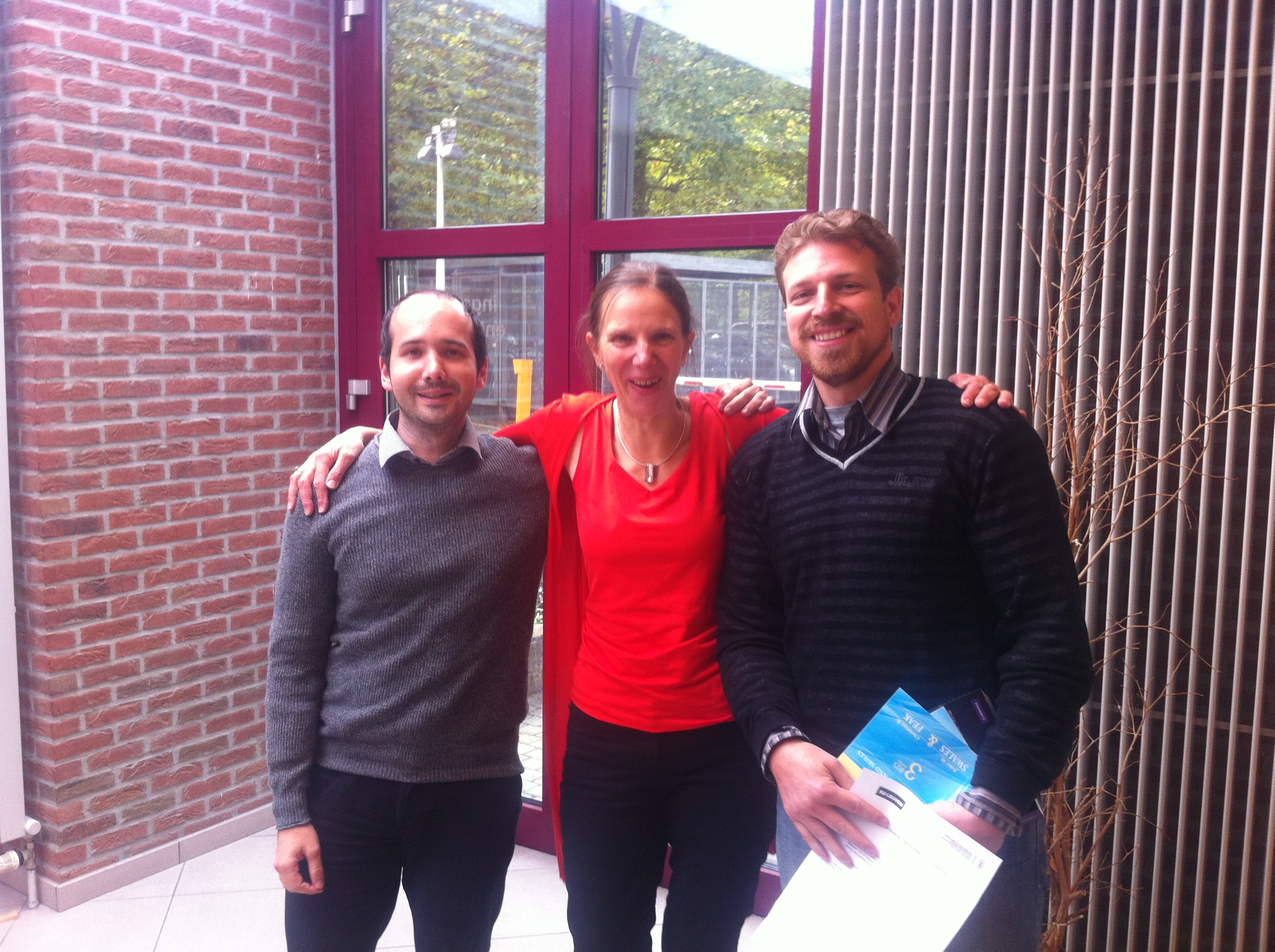
From September 23 to 28, NOAA AR 1850/Catania 83 was the main source of flaring activity which was situated in the B-level. The series of B-flares was interrupted by a C1.1 flare on September 24. The source region was this time NOAA AR 1846/Catania 79.
The only space weather relevant solar activity was seen on Sunday September 29. NOAA AR 1850/Catania 83 fired of an C1.6 flare peaking at 05:25UT. No big deal, wasn't it that this region was the neighbour of a large filament that erupted during the last part of September 29. A C1.2 flare peaking at 23:23UT was associated with the plasma eruption. The longitudinal filament had reached the central meridian on September 26.
The pictures below are difference image of SDO/AIA 131: two subsequent images are subtracted showing the differences between them. The part that light up is the place where the 131 Angstrom radiation is much stronger compared with the rest of the solar disk. It gives the flare location. You see that NOAA 1890/Catania 83 is a partner in crime.
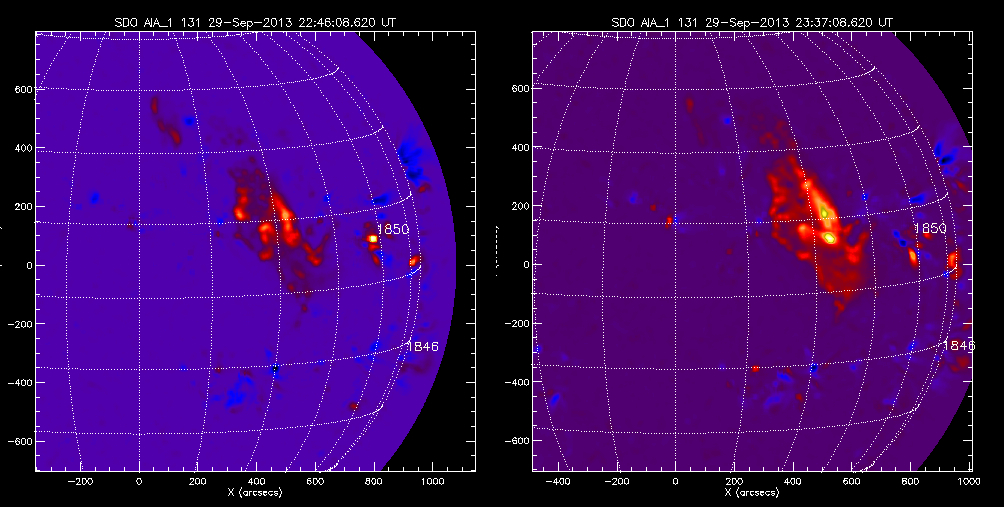
The geomagnetic field was not disturbed at all with the exception of one day: September 24. That day, ACE data show the arrival of a co-rotating interaction region (CIR) with a magnetic field slightly larger than 10nT and a more dense plasma, >10 particles/cm3. The solar wind speed increased almost simultaneously. The bump in the solar wind speed curve reached a value around 450 km/s. It took this plasma around 4 days to bridge the distance Sun-Earth. On September 20, a northern coronal hole passed the central meridian. The CIR followed by the fast wind is probably linked to this hole. The CIR was responsible for 1 interval of Kp=4 on September 24.
From September 25, the solar wind speed decreased. The lowest value was reached on September 30: slightly below 250 km/s.
The CIR and the decrease in solar wind speed are visible in the graph below showing three solar wind parameters measured by ACE at the L1 point: speed, density and total magnetic field.
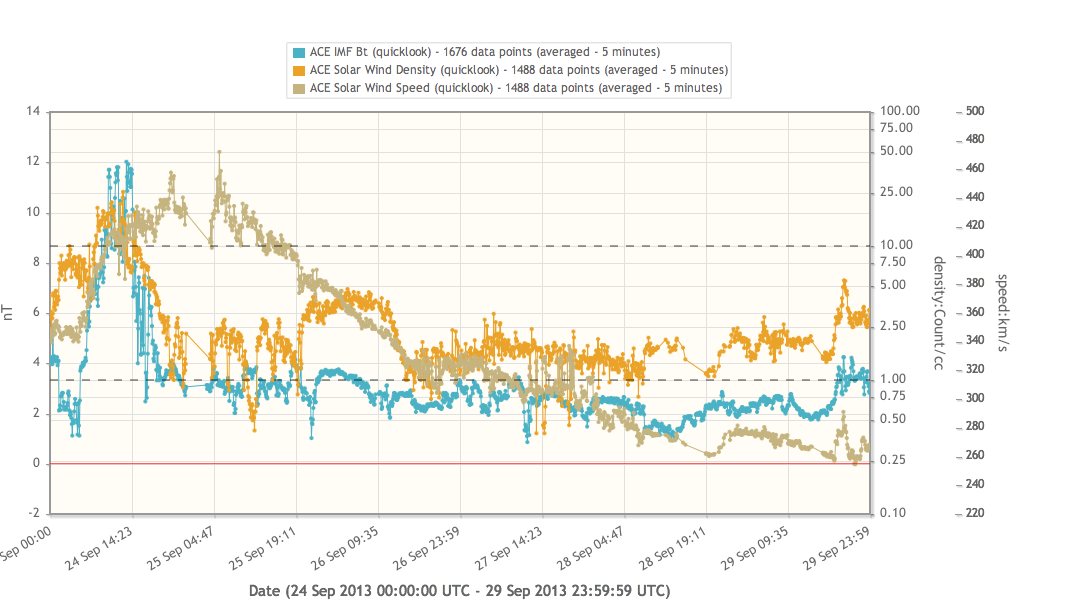
Solar (flaring) activity was low to very low throughout the week.
In order to view the activity of this week in more detail, we suggest to go to the following website from which all the daily (normal and difference) movies can be accessed: http://proba2.oma.be/ssa.
This page also lists the recorded flaring events.
A weekly overview movie can be found here (SWAP174; HelioViewer.org).
Details about some of this week's events, can be found further below.

Eruption on North East limb @ 06:37 UT SWAP difference image

Eruption on North East quad @ 20:31 UT SWAP difference image
Find a movie of the complete event here (SWAP difference movie)
http://proba2.oma.be/swap/data/mpg/movies/WeeklyReportMovies/WR183_Sep23toSep29/Events/20130924_Eruption_NorthEast_2031_swap_diff.mp4
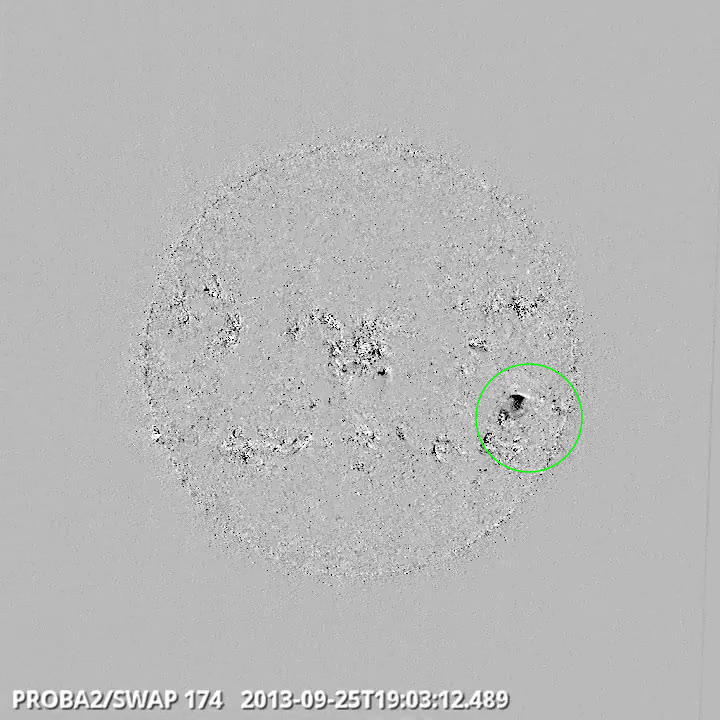
Eruption on South West quad @ 19:03 UT SWAP difference image

Prominence eruption on East limb @ 10:36 UT SWAP difference image
Find a movie of the complete event here (SWAP difference movie) The movie also contains a small
Eruption preceding this event
http://proba2.oma.be/swap/data/mpg/movies/WeeklyReportMovies/WR183_Sep23toSep29/Events/20130928_PromEruptions_SouthWest_0944_EastLimb_1036_swap_diff.mp4
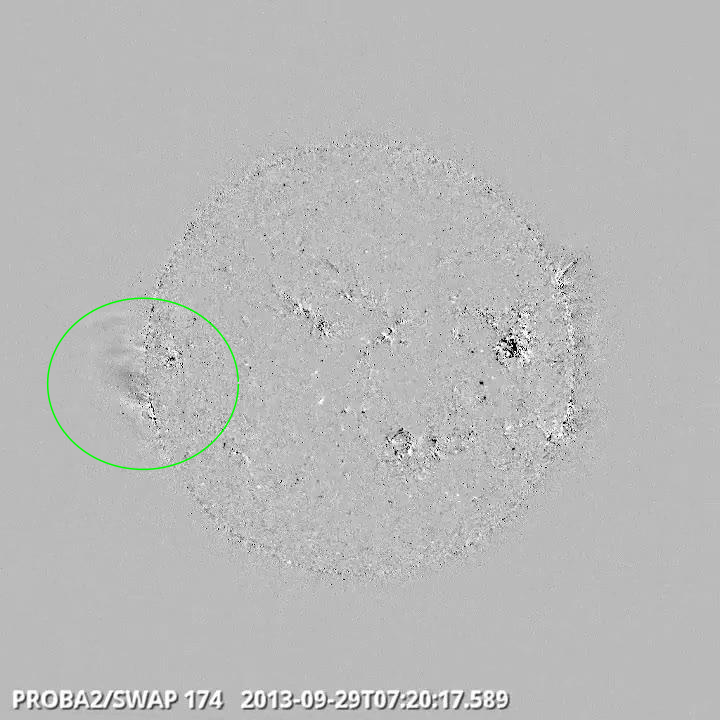
Prominence eruption on East limb @ 07:20 UT SWAP difference image
Find a movie of the complete event here (SWAP difference movie)
http://proba2.oma.be/swap/data/mpg/movies/WeeklyReportMovies/WR183_Sep23toSep29/Events/20130929_PromEruption_EastLimb_0720_swap_diff.mp4
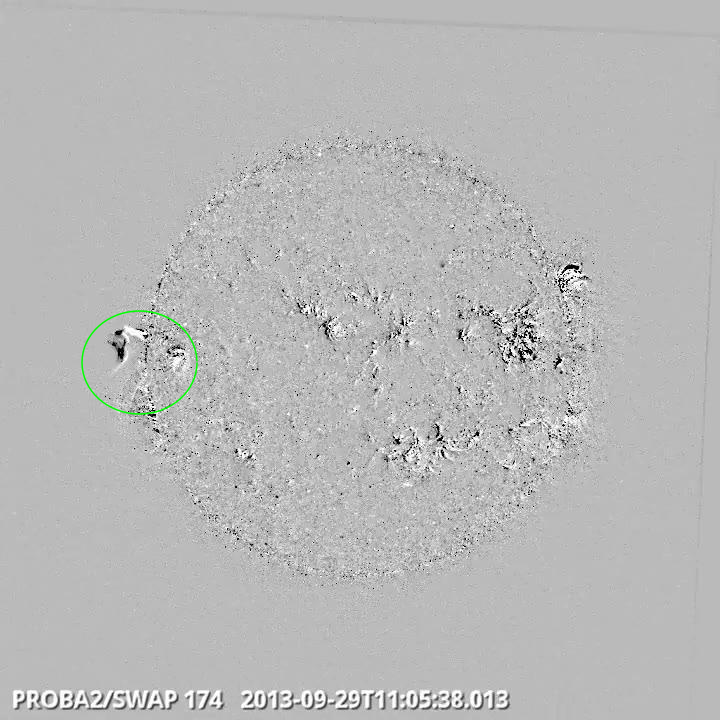
Prominence eruption on East Limb @ 11:05 UT SWAP difference image
Find a movie of the complete event here (SWAP difference movie)
http://proba2.oma.be/swap/data/mpg/movies/WeeklyReportMovies/WR183_Sep23toSep29/Events/20130929_PromEruption_EastLimb_1105_swap_diff.mp4
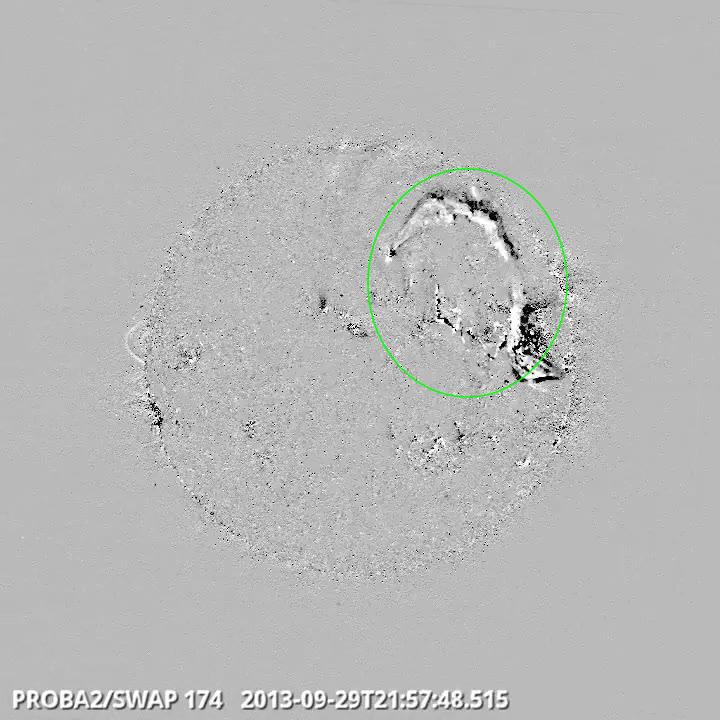
Filament eruption on North West quad @ 21:57 UT SWAP difference image
Find a movie of the complete event here (SWAP difference movie)
http://proba2.oma.be/swap/data/mpg/movies/WeeklyReportMovies/WR183_Sep23toSep29/Events/20130929_FilamEruption_NorthWest_2157_swap_diff.mp4
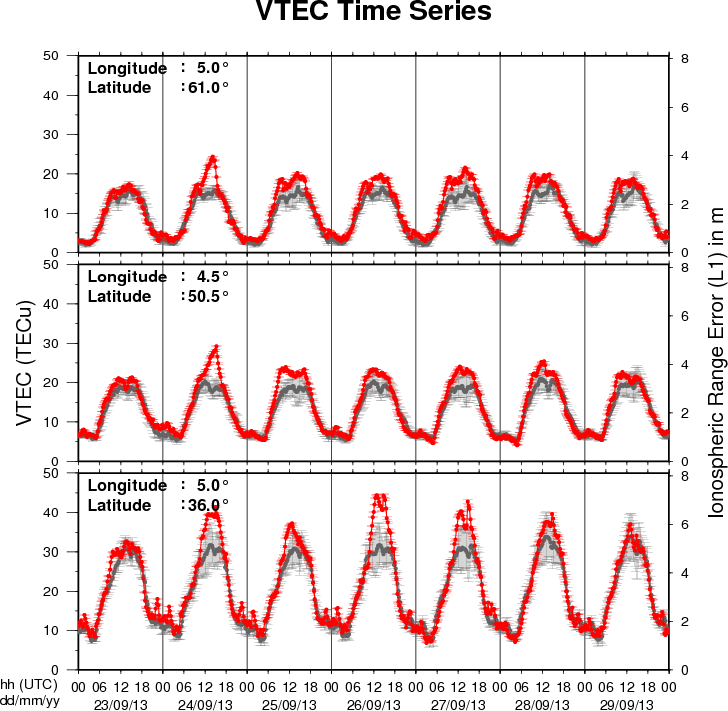
The figure shows the time evolution of the Vertical Total Electron Content (VTEC) (in red) during the last week at three locations:
a) in the northern part of Europe(N61°, 5°E)
b) above Brussels(N50.5°, 4.5°E)
c) in the southern part of Europe(N36°, 5°E)
This figure also shows (in grey) the normal ionospheric behaviour expected based on the median VTEC from the 15 previous days.
The VTEC is expressed in TECu (with TECu=10^16 electrons per square meter) and is directly related to the signal propagation delay due to the ionosphere (in figure: delay on GPS L1 frequency).
The Sun's radiation ionizes the Earth's upper atmosphere, the ionosphere, located from about 60km to 1000km above the Earth's surface.The ionization process in the ionosphere produces ions and free electrons. These electrons perturb the propagation of the GNSS (Global Navigation Satellite System) signals by inducing a so-called ionospheric delay.
See http://stce.be/newsletter/GNSS_final.pdf for some more explanations ; for detailed information, see http://gnss.be/ionosphere_tutorial.php
Start : 2013-10-07 - End : 2013-10-11
The aim of the workshop is to review the "state of the art"
theories about generation and propagation of Solar radio burst and
discuss the observational constrains and results that have been
provided in this area by the WIND & STEREO missions during the
last 20 years. Furthermore the STEREO & WIND observations will
be put in the context of other missions such as RHESSI and ground
based observatories. Finally, the preparation for the future
explorations foreseen with Solar Orbiter and Solar Probe Plus will
be discussed.
Website:
http://type3stereo.sciencesconf.org/
Start : 2013-10-24 - End : 2013-10-26
Initiated by Profs. Fang and Choudhury, the first Asian-Pacific
Solar Physics Meeting (APSPM) was held in Bangalore two years ago.
During the meeting, a consensus was achieved that it might be a
good idea to have the APSPM every three years. Somehow the second
APSPM was proposed to be held by mainland China in 2013. APSPM is
aimed to exchange the recent research results in solar physics in
the emerging asian-pacific region.
Asian-pacific regions are getting more and more active in solar
physics, as signified by the construction of big facilities,
including the Hinode satellite (Japan), SOXS (India), Chinese Solar
Radio Heliogragh, and Optical & Near-Infrared Solar Eruption
Tracer (ONSET). Therefore, colleagues have agreed to hold regional
solar physics meetings regularly. The first Asian-Pacific Solar
Physics Meeting (APSPM) was held in Bangalore during March 22-24
2011. During the meeting, a consensus was achieved that it might be
a good idea to have the APSPM every three years. Somehow the second
APSPM was proposed to be held by mainland China in 2013. APSPM is
aimed to exchange the recent research results in solar physics in
the emerging asian-pacific region.
Website:
http://sdac.nju.edu.cn/~solar/
Start : 2013-10-27 - End : 2013-10-31
Magnetic helicity has been intensively studied from
observational, theoretical, and many other aspects of solar
physics. For this meeting we would like to invite solar physicists
who are interested in the observational and theoretical studies of
the helicity, to encourage thorough discussions on the relevant hot
issues. The 1st Helicity Thinkshop was held successfully in 2009,
and now the 2nd one will be held on October 27-31, 2013 in Beijing,
China.
Website:
http://sun.bao.ac.cn/meetings/HT2013/
Start : 2013-10-28 - End : 2013-11-02
The Worshop and School on Radio Sun in Beijing and Inner
Mongolia during Oct.28 - Nov. 2, 2013 is the first international
academic seminar supported by the International Research Staff
Exchange Scheme of the Seventh Fromework Programme of the European
Union (FP7-IRSES-295272-RADIOSUN).
The primary aim of this programme is to establish close research
interaction and collaboration between the key research groups
involved in CSRH, SSRT, and ALMA projects and in development of
relevant theory and data analysis tools, through the systematic
research staff and knowledge exchange, joint research efforts
exploiting existing data and facilities, and preparing the future
world-class partnership in exploitation of the upcoming
facilities.
The Workshop and School welcome all solar physicsts and students
who are interested in solar radio astronomy to participate. We will
discuss and exchange the scientific frontier problems, including
the new-generation radio instruments (CSRH, Siberian
multi-frequency radioheliograph, LOFAR, ALMA, and other new
instruments), recent achievements and their scientific goals;
methods and techniques of data processing (for example, software,
radio image reconstructions, and method for studying various types
of solar radio fine structures); and the objectives of new
observational data and new mathematical methods.
Website:
http://beijingradiosun.csp.escience.cn/
Start : 2013-11-11 - End : 2013-11-22
Magnetic fields play an important role in many astrophysical
processes. But magnetic are difficult to detect and to model or
understand, since the fundamental equations describing the behavior
of magnetized plasmas are highly non-linear. Hence, magnetic fields
are often an inconvenient subject which is overlooked or simply
neglected. Such difficulty burdens the research on magnetic fields,
which has evolved to become a very technical subject, with many
small disconnected communities studying specific aspects and
details.
The school tries to amend the situation by providing a unifying
view of the subject. The students would have a chance to understand
the behavior of magnetic fields in all astrophysical contexts, from
cosmology to the Sun. From star-bursting regions to AGNs in
galaxies. The school will present a balanced yet complete review of
our knowledge. Extensions into the unknown are also important to
indicate present and future lines of research.
The Winter School will bring together in a relaxed working
atmosphere a number of the leading scientists in this field, PhD
students and recent postdocs. The conditions for a successful
interaction will be granted, including two special sessions for
those students that want to present their own work.
Website:
http://www.iac.es/winterschool/2013/
Start : 2013-11-12 - End : 2013-11-15
Since its launch in Sep-2006, more than 600 refereed papers have
been published based on Hinode observations, presenting many new
and important findings to the scientific community. However, due to
the unexpectedly low levels of solar activity, until now the focus
has mainly been on the more quiescent aspects of the solar cycle.
With the solar maximum expected this year, through cooperative
observations with SDO, IRIS, and ground based observatories, Hinode
observations should lead to our understanding of active Sun
phenomena, such as solar flares and CMEs, to be greatly improved.
Making Hinode-7 an excellent opportunity to discuss solar activity
in the current solar cycle and the related science through the use
Hinode data, as well as other solar/space weather data. It will
also be interesting to use this meeting to broaden our focus to
include the solar-stellar connection as a means to deepen our
understanding of solar activity.
Momentum is also gaining for Solar-C, which is being developed
as an international collaboration between Japan, US and Europe. To
further discuss this mission, the Solar-C science meeting will be
held on 11-Nov.
Website:
http://www.kwasan.kyoto-u.ac.jp/hinode-7/
Start : 2013-11-13 - End : 2013-11-13
Most space weather occurs due to the Sun's emissions which
can affect the Earth's space environment. Modern society is
ever more dependent upon ground-based & spaceborne technology
which can be vulnerable to space weather. Satellites, GPS, aviation
& the electric power industry are all at risk from this &
hence space weather is now included on the UK's National Risk
Register. It is important to have long-running, continuous
observations for forecasting, nowcasting & for research in
space weather. This public meeting, held during the peak of the 11
year solar cycle, addresses the deficiency in continuous, long-term
observations & how this might be overcome.
Website:
http://www.rmets.org/events/space-weather-importance-observations
Start : 2013-11-18 - End : 2013-11-22
This International CAWSES-II Symposium hosted by SCOSTEP
(Scientific Committee on Solar-Terrestrial Physics) will provide an
excellent opportunity to discuss the scientific accomplishments of
CAWSES-II and look forward to SCOSTEP's future programs at a moment
toward the end of its five-year period. The symposium will cover
the six major themes of CAWSES-II tasks: 1) What are the solar
influences on the Earth's climate?, 2) How will geospace respond to
an altered climate?, 3) How does short-term solar variability
affect the geospace environment?, 4) What is the geospace response
to variable inputs from the lower atmosphere?, 5) Capacity
Building, 6) Informatics and eScience. The main functions of
CAWSES-II are to help coordinate international activities in
observations, modeling, and applications crucial to achieving this
understanding, to involve scientists in both developed and
developing countries, and to provide educational opportunities for
students of all levels. The symposium offers keynotes/lectures that
will be interesting for all participants every morning and more
specific sessions of presentations in the afternoon. We welcome all
those who are involved and/or interested in CAWSES-II to Nagoya in
the autumn when we will have the pleasure of being surrounded by
beautiful colorful leaves of this season.
Website:
http://www.cawses.org/CAWSES/leaflet_CAWSES-II_120229.pdf
Start : 2013-11-18 - End : 2013-11-22
The 10th Edition of the European Space Weather
Week will take place on 18-22nd
November 2013 in Belgium. The venue will be confirmed early next
year, but mark your calendars now for the 10th Anniversary of this
growing European event.
The ESWW will again adopt the central aim of bringing together
the diverse groups in Europe working on different aspects of Space
Weather
. This includes but isn't
limited to the scientific community, the engineering community,
applications developers, service providers and service end users.
The meeting organisation will again be coordinated by the Belgian
Solar-Terrestrial Centre of Excellence (STCE), ESA
and the Space Weather
Working Team. The local
organisation will be done by the STCE.
Website:
http://www.stce.be/esww10/
Start : 2013-11-26 - End : 2013-11-28
The 1st SPRING (Solar Physics Research Integrated Network Group)
workshop is being held from November 26 - 28, 2013 at the scenic
Brugger's Hotel Park by Titisee hosted by the Kiepenheuer-Institut
für Sonnenphysik in Freiburg, Germany.
The purpose of the workshop is to work on the scientific
requirements for a new ground-based network of telescopes for
full-disk synoptic observations of the Sun.
The desire for such a new network is motivated by new scientific
research directions in solar physics, the requirement of real-time
context data for high-resolution solar telescopes, and the need of
continuous, long-term, consistent, and reliable solar data as
foundation for space weather prediction.
Website:
http://www3.kis.uni-freiburg.de/~mroth/spring.html
Start : 2013-12-13 - End : 2013-12-13
The inclusion of space weather in the National Risk Assessment
in 2012 means that there is now an urgent need for dialogue between
those doing the science of space weather and those using the data
to forecast, understand and mitigate the risks.
Since the Sun is currently at the peak of its cycle - a time
when space weather events become more frequent - we have a timely
opportunity to study how a range of solar activity ultimately lead
to magnetospheric, ionospheric and ground level disturbances.
The goal of this meeting is to bring together those working
across the broad range of space weather activities in the UK to
discuss the current status of observations and recent new advances
in the theories and models of the phenomena of space weather.
Website:
http://www.mssl.ucl.ac.uk/~lmg/spaceweather/Overview.html
Start : 2014-06-23 - End : 2014-06-27
The meeting in honour of Prof. Zdenek Svestka will cover issues
of the physics of solar and stellar flares.
Website:
http://solarflares2014.cz/
Start : 2014-08-02 - End : 2014-08-10
The 40th COSPAR Scientific Assembly will be held in Moscow,
Russia from 2 - 10 August 2014. This Assembly is open to all bona
fide scientists.
Website:
http://www.cospar-assembly.org/
Start : 2014-08-31 - End : 2014-09-05
Low-frequency waves (ULF, ELF and VLF) in space plasmas have
been studied for many decades. In our solar system, such waves
occur in the magnetospheres of planets and in the solar wind; more
recently they have also been confirmed on the Sun. In spite of the
great differences in the plasma properties of these regions, the
overarching schemes are wave generation, wave propagation, and wave
dissipation, which are three fundamental aspects of any kind of
waves. A fourth aspect of these waves is their application, either
with direct benefit to humans or for scientific pursuit. Therefore,
this Chapman conference will provide a forum in which various wave
communities can come together and discuss recent achievements of
observational, theoretical, and modeling studies.
Website:
http://chapman.agu.org/spaceplasmas/
Start : 2014-09-08 - End : 2014-09-12
The European Solar Physics Meetings aim to highlight all aspects
of modern solar physics, including observation and theory that span
from the interior of the Sun out into the wider heliosphere. These
meetings provide a broad, yet stimulating, environment for European
and international scientists to share their research in solar
physics.
The meeting will mostly comprise of contributed talks and poster
presentations, with several invited review talks (typically one per
session). Posters will be on display for the whole meeting in close
proximity to the lecture theatre. Refreshments will be served in
the poster viewing area during two dedicated coffee/poster breaks
on each full day.
Website: http://www.espm14.ie/
Start : 2015-06-22 - End : 2015-06-26
The Fourteenth International Solar Wind Conference will be held
for the first time ever in China, from 22 to 26 June 2015, at
Weihai in the Shandong province. It will be jointly organized by
the School of Earth and Space Sciences of Peking University and the
newly-established Institute of Space Sciences of Shandong
University. The meeting will take place in the Space Science
Building of Shandong University, a venue located within walking
distance to the beautiful Weihai International Bathing Beach, one
of the most popular scenic areas of northern China.
The conference will cover all aspects of solar wind physics,
with invited reviews and contributed papers that examine the
current research and outline the future research in all the
relevant solar wind fields.
Website: not available yet